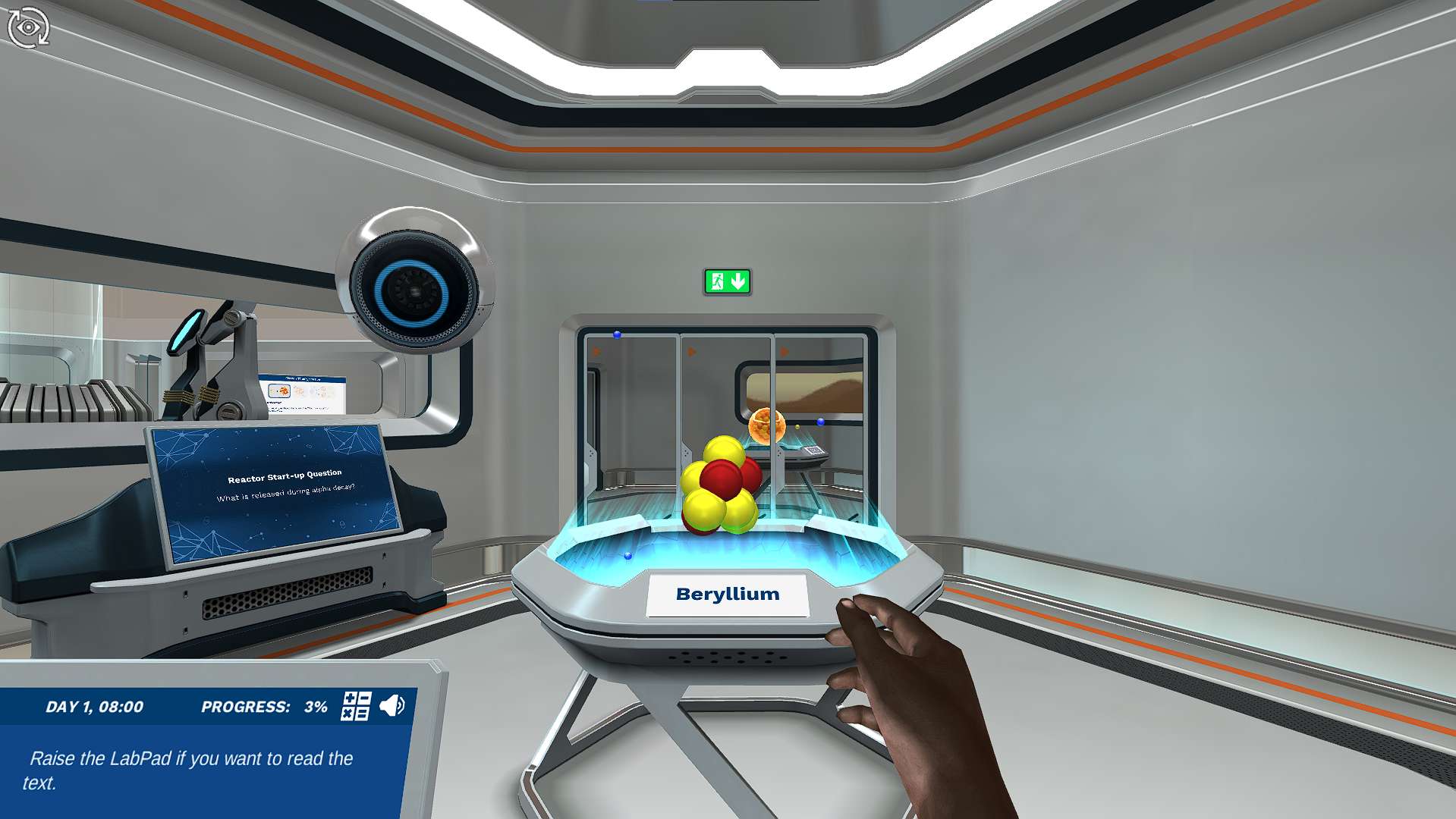Heading 1
Heading 2
Heading 3
Heading 4
Heading 5
Heading 6
Lorem ipsum dolor sit amet, consectetur adipiscing elit, sed do eiusmod tempor incididunt ut labore et dolore magna aliqua. Ut enim ad minim veniam, quis nostrud exercitation ullamco laboris nisi ut aliquip ex ea commodo consequat. Duis aute irure dolor in reprehenderit in voluptate velit esse cillum dolore eu fugiat nulla pariatur.
Block quote
Ordered list
- Item 1
- Item 2
- Item 3
Unordered list
- Item A
- Item B
- Item C
Bold text
Emphasis
Superscript
Subscript
About This Simulation
You're on a mission to learn about fission and how we harness it as a sustainable energy source. Journey into the heart of a reactor and answer the lab's security questions to activate it.
Learning Objectives
- Demonstrate that neutrons being added to large nuclei creates instability, inducing fission and the subsequent nuclear chain reaction
- Demonstrate that the total number of neutrons plus protons is the same before and after the nuclear process (fission).
- Demonstrate that the products of fission are unstable and they undergo radioactive decay
About This Simulation
Lab Techniques
Related Standards
- HS-PS1-8
Learn More About This Simulation
Discover our most powerful energy source! In this simulation, you will learn about the science of nuclear fission and nuclear power. What does it look like when we split the atom? What reactions are possible with fission? Why does it make radioactive waste? With your team's nuclear scientist missing, it's up to you to figure out all of these questions.
Activate the reactor!
On a mission to find the secrets of sustainable energy sources, your team needs you to activate an abandoned fission reactor to generate power. However, your nuclear expert has gone missing so you will have to learn the science of nuclear fission! To understand fission you will be working through interactive learning activities, making hypotheses, and exploring insightful animations. Applying this knowledge will turn on the reactor and help your team on their adventure!
Hold atoms in your hands!
Fission happens on an atomic scale and can be tricky to visualize and therefore can be difficult to learn. With this simulation, you will see memorable animations to make the science feel real! Want to experience the hazardous decay of uranium but don't have millions of years to wait around? We can simulate the fission and decay of atoms in a more reasonable amount of time!
Restart the reactor.
Ahead of you is the reactor, locked behind three security questions. As this is a fission reactor, the questions are all on the topic of nuclear science and fission. These questions make sure if you're going to harness the secrets of renewable energy, you have got to understand it! Think you're up for the challenge?
For Science Programs Providing a Learning Advantage
Boost STEM Pass Rates
Boost Learning with Fun
75% of students show high engagement and improved grades with Labster
Discover Simulations That Match Your Syllabus
Easily bolster your learning objectives with relevant, interactive content
Place Students in the Shoes of Real Scientists
Practice a lab procedure or visualize theory through narrative-driven scenarios


FAQs
Find answers to frequently asked questions.
Heading 1
Heading 2
Heading 3
Heading 4
Heading 5
Heading 6
Lorem ipsum dolor sit amet, consectetur adipiscing elit, sed do eiusmod tempor incididunt ut labore et dolore magna aliqua. Ut enim ad minim veniam, quis nostrud exercitation ullamco laboris nisi ut aliquip ex ea commodo consequat. Duis aute irure dolor in reprehenderit in voluptate velit esse cillum dolore eu fugiat nulla pariatur.
Block quote
Ordered list
- Item 1
- Item 2
- Item 3
Unordered list
- Item A
- Item B
- Item C
Bold text
Emphasis
Superscript
Subscript
A Labster virtual lab is an interactive, multimedia assignment that students access right from their computers. Many Labster virtual labs prepare students for success in college by introducing foundational knowledge using multimedia visualizations that make it easier to understand complex concepts. Other Labster virtual labs prepare learners for careers in STEM labs by giving them realistic practice on lab techniques and procedures.
Labster’s virtual lab simulations are created by scientists and designed to maximize engagement and interactivity. Unlike watching a video or reading a textbook, Labster virtual labs are interactive. To make progress, students must think critically and solve a real-world problem. We believe that learning by doing makes STEM stick.
Yes, Labster is compatible with all major LMS (Learning Management Systems) including Blackboard, Canvas, D2L, Moodle, and many others. Students can access Labster like any other assignment. If your institution does not choose an LMS integration, students will log into Labster’s Course Manager once they have an account created. Your institution will decide which is the best access method.
Labster is available for purchase by instructors, faculty, and administrators at education institutions. Purchasing our starter package, Labster Explorer, can be done using a credit card if you are located in the USA, Canada, or Mexico. If you are outside of North America or are choosing a higher plan, please speak with a Labster sales representative. Compare plans.
Labster supports a wide range of STEM courses at the high school, college, and university level across fields in biology, chemistry, physics, and health sciences. You can identify topics for your courses by searching our Content Catalog.















